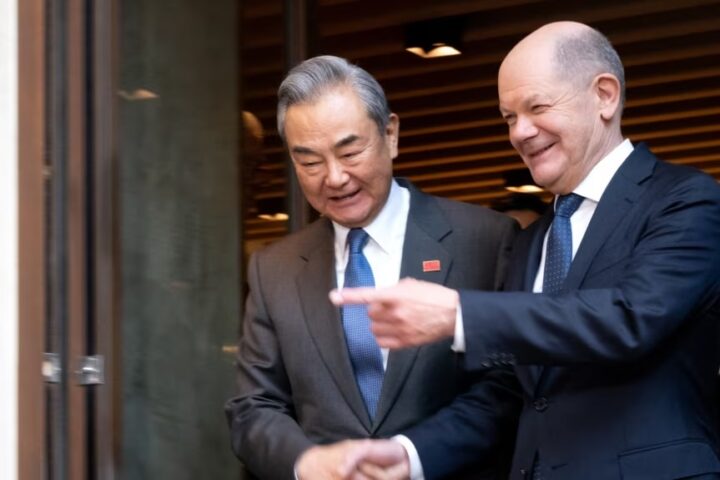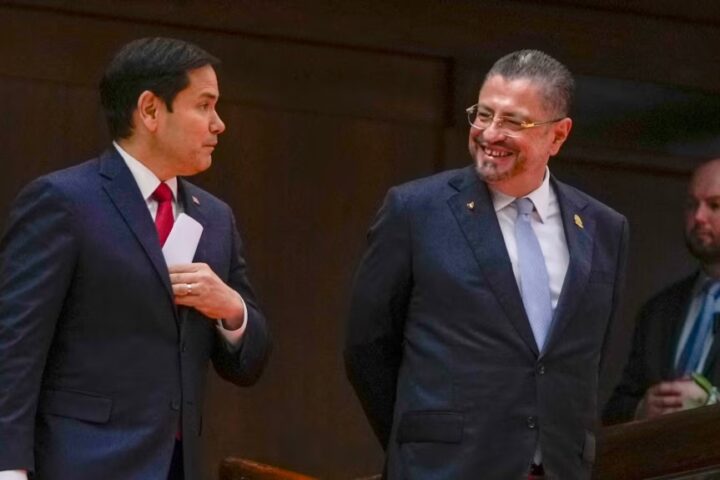The Sledgehammer War – A deadly missile blast in Poland raises fears of escalation – but also shines a spotlight on the barriers to a broader war. Guilty verdicts in the MH17 trial are grim reminders that Russia’s war on Ukraine began long before he February invasion. And a gruesome video serves as a disturbing sign of where Russia is today — and where it may be headed.
Here are some of the key developments in Russia over the past week and some of the takeaways going forward.
The Big Story
President Vladimir Putin and other officials have sought to depict Russia’s unprovoked war of aggression against Ukraine as a conflict with NATO and the West — and one in which Moscow is on the defensive, forced to fight or risk losing its physical and cultural sovereignty.
The motives behind such a misrepresentation seem pretty clear: At home, it’s an attempt to justify the war and rally Russians around a foe familiar since the Cold War; for the wider world, it’s a bid to cast Russia as the valiant defender against U.S. dominance.
The Kremlin has also used the prospect of escalation to a wider war – one pitting Russia directly against NATO and potentially involving nuclear weapons – to try to frighten Western nations into decreasing or dropping their support for Ukraine, paving the way for Putin to achieve at least some of his goals there.
But an incident on November 15 in which a missile killed two people in a Polish village near Ukraine’s border, if anything, seemed to show the restraints that serve to rein in a potential escalation, highlighting something often obscured by Russian propaganda: NATO is not out to go to war against Russia.
It’s not clear exactly what happened in Przewodow. Poland and NATO said on November 17 that it was most likely a Ukrainian air-defense missile that caused the deadly explosion, and the United States accepted that preliminary conclusion, while Kyiv disputed it.
What is clear is that Russia’s war on its western neighbor spilled over into a NATO country for the first time since the large-scale invasion of Ukraine on February 24. NATO Secretary-General Jens Stoltenberg stressed that it was “not Ukraine’s fault” and that “Russia bears ultimate responsibility as it continues its illegal war against Ukraine.”
Russian officials called the incident a “provocation” and suggested that NATO is spoiling for a fight.
“The incident with the Ukrainian-alleged ‘missile strike’ on a Polish farm proves just one thing: Waging a hybrid war against Russia, the West moves closer to the [sic] world war,” Dmitry Medvedev, the Putin ally and former president and prime minister, wrote on Twitter.
But as with most statements about the war from Medvedev, who has transformed himself into a font of anti-Western vitriol since the invasion, there was no evidence to support this one.
Before it emerged that Ukraine appeared to have fired the missile, there was talk of Poland invoking Article 4 or even Article 5 – sections of the NATO treaty that provide for collective consultation and defense, respectively – but there does not appear to have been a rush to do so.
Now that Russia is being held responsible by the West but not accused of firing the missile, an incident that is clearly momentous on at least one level may end up having little effect on the course of the war.
It is unlikely to lead to a decrease in Western support for Ukraine or a change in the Western perception of Russia’s intentions, but it might serve as a useful drill for NATO, enabling the alliance to think quickly and collectively at the next sign of an emerging crisis.
The Bigger Picture
The missile’s victims in Poland were the only people to be killed in a NATO country as a direct result of Russia’s February invasion of Ukraine. But it was not the first time that civilians from countries other than Ukraine and Russia have been killed as a result of Moscow’s aggression against Kyiv.
That fact was underscored on November 17, when a Dutch court convicted two Russians and a Ukrainian of murder for their role in the deaths of 298 people killed when a passenger jet en route from Amsterdam to Kuala Lumpur was shot down over territory held by Russia-backed forces in eastern Ukraine in July 2014.
The court found that a Buk missile brought in from Russia and fired by forces who were ultimately under Russian control brought down Malaysia Airlines flight MH17. The three men convicted were sentenced in absentia to life in prison, while a fourth defendant was acquitted.
None of the defendants attended the trial. They are presumably being sheltered by Russia, which denies responsibility for the downing of MH17, despite the evidence, and has issued several claims meant to paint a different picture of what happened – some of them outlandish and all of them rejected by the court.
The fighting that has occurred since Russia’s invasion of Ukraine on February 24 is often referred to as “the war,” but in fact it is a dramatic escalation of the war that erupted in the Donbas – the eastern provinces of Donetsk and Luhansk – after Moscow seized Crimea and fomented separatism across much of Ukraine.
The passengers and crew of MH17 are among the more than 13,000 people killed between the time the conflict broke out – three months before the Boeing 777 was shot down – and the invasion in February. The pain and grief endured by their relatives and friends for more than eight years was in evidence again as the verdict was delivered.
The Real Big Story
For many people in Ukraine, the pain and grief brought on by the war are just beginning.
The deadly incident in Poland came amid some of the most intense Russian strikes on Ukraine, where Moscow has been targeting energy facilities and other vital infrastructure, darkening cities and depriving civilians of water, power, and heat as winter approaches.
Russian forces have also continued to kill civilians, frequently hitting homes and apartment buildings in villages, towns, and cities across the country.
In the Kherson Oblast, where Russian forces retreated from the regional capital last weekend and Ukraine has retaken swaths of territory, evidence of atrocities by the occupying troops is emerging – just as it emerged after Russian retreats from northern Ukraine in the spring and parts of the east more recently.
The Russian retreat from Kherson has increased Ukraine’s hopes of recapturing all the territory Russia has seized since 2014, potentially including Crimea. It has made the prospect of Moscow ever controlling, in their entirety, all four regions that Putin claimed as part of Russia earlier this fall ever more unlikely than it had been before.
But the prospects for peace or even peace talks anytime soon appear slim, as “at present there is nothing to negotiate seriously,” Mark Galeotti, executive director of the consultancy Mayak Intelligence and an honorary professor at University College London, wrote in a November 12 article in The Sunday Times of London.
“Although Moscow keeps claiming to be willing to talk, so long as it refuses to countenance the return of occupied territories, there is not enough common ground to make talks meaningful, especially as a cease-fire maintaining the present positions would be very much to the Russians’ advantage, granting them a breathing space in which to regroup and rearm,” Galeotti wrote.
A Russian Story
“Putin is, after all, probably not expecting to win this war on the battlefield,” he went on. “Rather, by denying Ukraine a quick win and signaling that Russia is able to leverage its resources to keep the war running indefinitely, he hopes to shake the West’s willingness to continue to arm and bankroll the conflict.”
But as the war grinds on and major setbacks such as the retreat from Kherson pile up, Putin also risks repercussions at home – from the economic effects of the war he has unleashed, among other things.
While the ruble rate and GDP have fared better than many expected when Russia launched the February invasion and the West imposed new sanctions, a closer look reveals “that the damage is in fact severe: The Russian economy is destined for a long period of stagnation,” Konstantin Sonin, a professor at the University of Chicago’s Graduate School of Public Policy Studies, wrote in a November 15 article in the journal Foreign Affairs.
With the state tightening its already stifling control over the private sector since the invasion, but also “creating new power centers” by turning to private military companies and regional battalions to bolster manpower in the war, Sonin forecasts that a period of “decentralized corruption” reminiscent of the 1990s, the turbulent decade that followed the Soviet Union’s collapse, could take hold.
In that era, “Russian business owners relied on private security, mafia ties, and corrupt officials to maintain control of newly privatized enterprises,” he wrote. “Criminal gangs employing veterans of the [Soviet] war in Afghanistan offered ‘protection’ to the highest bidder or simply plundered profitable businesses.”
“The mercenary groups that Putin created to fight in Ukraine will play the same role in the future,” Sonin predicted, adding in a tweet that it could look “like [the] 1990s, yet with private armies instead of common criminals. More experienced, better armed.”
An increasingly prominent figure who would fit well into that version of the near future – and might play a major part in making it happen – is Yevgeny Prigozhin, a Kremlin go-to guy who appears to have been deeply involved in everything from election meddling in the United States to Russia’s military intervention in Syria.
After years of denials, Prigozhin acknowledged in September that he founded Vagner, a private military outfit whose members – now including convicts sprung from prison – are fighting in Ukraine. Prigozhin, meanwhile, has been picking political fights with the Defense Ministry and the governor of St. Petersburg.
If Russia’s near future involves armed paramilitaries playing more prominent roles in the economy and domestic affairs, a video that was published last week on a Telegram channel with ties to Vagner provided a gruesome preview of the coming era. It purports to show a 55-year-old Vagner recruit who had allegedly defected to Ukraine being killed with a sledgehammer.
In the second of two statements on the video, Prigozhin denied that Vagner was involved and – without grounds or evidence – suggested U.S. intelligence was behind it. In the first, though, he repeatedly voiced winking support for the purported killing and said the clip should have been titled A Dog Dies A Dog’s Death.
Where does Putin fit into this unsettling but plausible potential future? That appears increasingly unclear.
“Despite some frenzied speculation around Russia’s loss of the occupied Ukrainian region of Kherson this week, it is still too soon to predict when and how President Vladimir Putin will surrender power – whether it will be because he is ousted, retires, or simply dies in office,” Galeotti wrote in a November 11 opinion article for CNN.
While “for now, the chances of a palace coup are scarcely greater than those of Putin being toppled by protests in the streets,” he wrote, “what is happening is that his system is becoming increasingly brittle, losing the resources which in the past have provided the resilience to respond to unexpected challenges.”
Whatever the eventual outcome, “Putin’s dreams of establishing Russia as a great power on the back of its military strength are over, and so too are his ambitions of securing a legacy as one of the nation’s great state-builders,” Galeotti concluded. “His military machine is broken; his country’s economy so scarred that it will take years to recover; his reputation as a geopolitical mastermind in tatters. Putin-the-man may still cling to power for years, but Putin-the-legend is dead.”
Steve Gutterman














